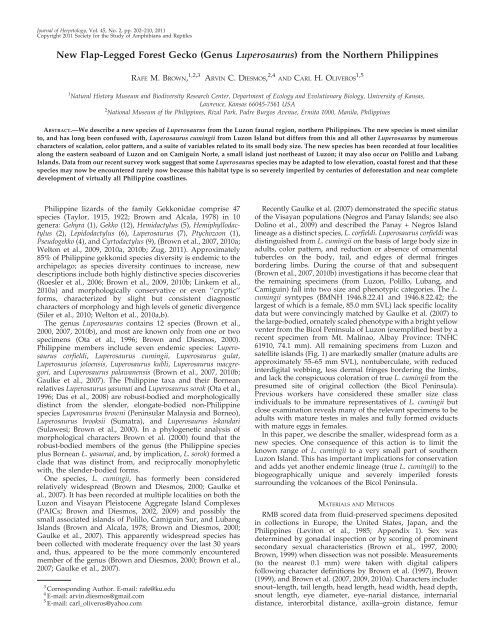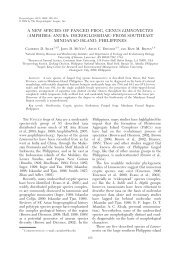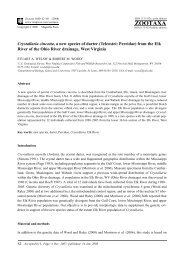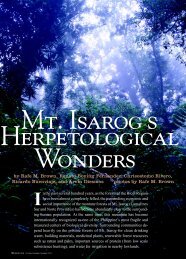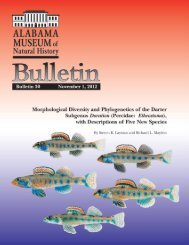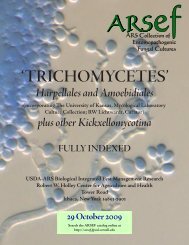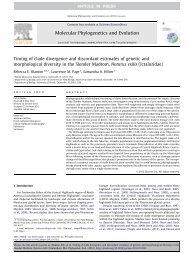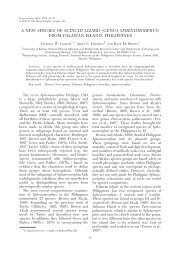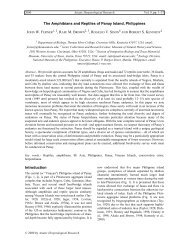New Flap-Legged Forest Gecko (Genus Luperosaurus ... - BioOne
New Flap-Legged Forest Gecko (Genus Luperosaurus ... - BioOne
New Flap-Legged Forest Gecko (Genus Luperosaurus ... - BioOne
You also want an ePaper? Increase the reach of your titles
YUMPU automatically turns print PDFs into web optimized ePapers that Google loves.
Journal of Herpetology, Vol. 45, No. 2, pp. 202–210, 2011Copyright 2011 Society for the Study of Amphibians and Reptiles<strong>New</strong> <strong>Flap</strong>-<strong>Legged</strong> <strong>Forest</strong> <strong>Gecko</strong> (<strong>Genus</strong> <strong>Luperosaurus</strong>) from the Northern PhilippinesRAFE M. BROWN, 1,2,3 ARVIN C. DIESMOS, 2,4 AND CARL H. OLIVEROS 1,51 Natural History Museum and Biodiversity Research Center, Department of Ecology and Evolutionary Biology, University of Kansas,Lawrence, Kansas 66045-7561 USA2 National Museum of the Philippines, Rizal Park, Padre Burgos Avenue, Ermita 1000, Manila, PhilippinesABSTRACT.—We describe a new species of <strong>Luperosaurus</strong> from the Luzon faunal region, northern Philippines. The new species is most similarto, and has long been confused with, <strong>Luperosaurus</strong> cumingii from Luzon Island but differs from this and all other <strong>Luperosaurus</strong> by numerouscharacters of scalation, color pattern, and a suite of variables related to its small body size. The new species has been recorded at four localitiesalong the eastern seaboard of Luzon and on Camiguin Norte, a small island just northeast of Luzon; it may also occur on Polillo and LubangIslands. Data from our recent survey work suggest that some <strong>Luperosaurus</strong> species may be adapted to low elevation, coastal forest and that thesespecies may now be encountered rarely now because this habitat type is so severely imperiled by centuries of deforestation and near completedevelopment of virtually all Philippine coastlines.Philippine lizards of the family Gekkonidae comprise 47species (Taylor, 1915, 1922; Brown and Alcala, 1978) in 10genera: Gehyra (1), Gekko (12), Hemidactylus (5), Hemiphyllodactylus(2), Lepidodactylus (6), <strong>Luperosaurus</strong> (7), Ptychozoon (1),Pseudogekko (4), and Cyrtodactylus (9), (Brown et al., 2007, 2010a;Welton et al., 2009, 2010a, 2010b; Zug, 2011). Approximately85% of Philippine gekkonid species diversity is endemic to thearchipelago; as species diversity continues to increase, newdescriptions include both highly distinctive species discoveries(Roesler et al., 2006; Brown et al., 2009, 2010b; Linkem et al.,2010a) and morphologically conservative or even ‘‘cryptic’’forms, characterized by slight but consistent diagnosticcharacters of morphology and high levels of genetic divergence(Siler et al., 2010; Welton et al., 2010a,b).The genus <strong>Luperosaurus</strong> contains 12 species (Brown et al.,2000, 2007, 2010b), and most are known only from one or twospecimens (Ota et al., 1996; Brown and Diesmos, 2000).Philippine members include seven endemic species: <strong>Luperosaurus</strong>corfieldi, <strong>Luperosaurus</strong> cumingii, <strong>Luperosaurus</strong> gulat,<strong>Luperosaurus</strong> joloensis, <strong>Luperosaurus</strong> kubli, <strong>Luperosaurus</strong> macgregori,and <strong>Luperosaurus</strong> palawanensis (Brown et al., 2007, 2010b;Gaulke et al., 2007). The Philippine taxa and their Borneanrelatives <strong>Luperosaurus</strong> yasumai and <strong>Luperosaurus</strong> sorok (Ota et al.,1996; Das et al., 2008) are robust-bodied and morphologicallydistinct from the slender, elongate-bodied non-Philippinespecies <strong>Luperosaurus</strong> browni (Peninsular Malaysia and Borneo),<strong>Luperosaurus</strong> brooksii (Sumatra), and <strong>Luperosaurus</strong> iskandari(Sulawesi; Brown et al., 2000). In a phylogenetic analysis ofmorphological characters Brown et al. (2000) found that therobust-bodied members of the genus (the Philippine speciesplus Bornean L. yasumai, and, by implication, L. sorok) formed aclade that was distinct from, and reciprocally monophyleticwith, the slender-bodied forms.One species, L. cumingii, has formerly been consideredrelatively widespread (Brown and Diesmos, 2000; Gaulke etal., 2007). It has been recorded at multiple localities on both theLuzon and Visayan Pleistocene Aggregate Island Complexes(PAICs; Brown and Diesmos, 2002, 2009) and possibly thesmall associated islands of Polillo, Camiguin Sur, and LubangIslands (Brown and Alcala, 1978; Brown and Diesmos, 2000;Gaulke et al., 2007). This apparently widespread species hasbeen collected with moderate frequency over the last 30 yearsand, thus, appeared to be the more commonly encounteredmember of the genus (Brown and Diesmos, 2000; Brown et al.,2007; Gaulke et al., 2007).3 Corresponding Author. E-mail: rafe@ku.edu4 E-mail: arvin.diesmos@gmail.com5 E-mail: carl_oliveros@yahoo.comRecently Gaulke et al. (2007) demonstrated the specific statusof the Visayan populations (Negros and Panay Islands; see alsoDolino et al., 2009) and described the Panay + Negros Islandlineage as a distinct species, L. corfieldi. <strong>Luperosaurus</strong> corfieldi wasdistinguished from L. cumingii on the basis of large body size inadults, color pattern, and reduction or absence of ornamentaltubercles on the body, tail, and edges of dermal fringesbordering limbs. During the course of that and subsequent(Brown et al., 2007, 2010b) investigations it has become clear thatthe remaining specimens (from Luzon, Polillo, Lubang, andCamiguin) fall into two size and phenotypic categories. The L.cumingii syntypes (BMNH 1946.8.22.41 and 1946.8.22.42; thelargest of which is a female, 85.0 mm SVL) lack specific localitydata but were convincingly matched by Gaulke et al. (2007) tothe large-bodied, ornately scaled phenotype with a bright yellowventer from the Bicol Peninsula of Luzon (exemplified best by arecent specimen from Mt. Malinao, Albay Province: TNHC61910, 74.1 mm). All remaining specimens from Luzon andsatellite islands (Fig. 1) are markedly smaller (mature adults areapproximately 55–65 mm SVL), nontuberculate, with reducedinterdigital webbing, less dermal fringes bordering the limbs,and lack the conspicuous coloration of true L. cumingii from thepresumed site of original collection (the Bicol Peninsula).Previous workers have considered these smaller size classindividuals to be immature representatives of L. cumingii butclose examination reveals many of the relevant specimens to beadults with mature testes in males and fully formed oviductswith mature eggs in females.In this paper, we describe the smaller, widespread form as anew species. One consequence of this action is to limit theknown range of L. cumingii to a very small part of southernLuzon Island. This has important implications for conservationand adds yet another endemic lineage (true L. cumingii) to thebiogeographically unique and severely imperiled forestssurrounding the volcanoes of the Bicol Peninsula.MATERIALS AND METHODSRMB scored data from fluid-preserved specimens depositedin collections in Europe, the United States, Japan, and thePhilippines (Leviton et al., 1985; Appendix 1). Sex wasdetermined by gonadal inspection or by scoring of prominentsecondary sexual characteristics (Brown et al., 1997, 2000;Brown, 1999) when dissection was not possible. Measurements(to the nearest 0.1 mm) were taken with digital calipersfollowing character definitions by Brown et al. (1997), Brown(1999), and Brown et al. (2007, 2009, 2010a). Characters include:snout–length, tail length, head length, head width, head depth,snout length, eye diameter, eye–narial distance, internarialdistance, interorbital distance, axilla–groin distance, femur
NEW PHILIPPINE LUPEROSAURUS 203FIG. 1. Map of Luzon Island in relation to the Philippines (inset)with the type locality of <strong>Luperosaurus</strong> angliit (Municipality of Baler,Aurora Province) indicated with an open circle. Comparison of the<strong>Luperosaurus</strong> cumingii syntypes (BMNH 1946.8.22.41 and 1946.8.22.42)to recent collections (UF 77829, TNHC 61910) suggests that Cuming’s(1836–1840) types most probably originated on the Bicol Peninsula(Gaulke et al., 2007).length, tibia–fibula length, first and fourth toe lengths, tailwidth, tail depth, number of supralabials and infralabialsposteriorly to the point labials are no longer differentiated;preanofemoral pore-bearing scales, subdigital lamellae underfingers and toes, transverse midbody scales, paravertebral andmidventral scales between midpoints of limb insertions, tailannuli, and subcaudals. We employ lineage-based speciesconcepts (Simpson, 1961; Wiley, 1978; Frost and Hillis, 1990; deQueiroz, 1999) in an effort to recognize ancestor-descendentpopulation segments with a distinct evolutionary history,evidence of lineage cohesion, and in cases where thehypothesis of conspecificity can be confidently rejected (Brownand Diesmos, 2002; Brown and Guttman, 2002; Gaulke et al.,2007).SYSTEMATICS<strong>Luperosaurus</strong> angliit sp. nov.Figures 2–4Holotype.—PNM 9702 (Field Collection number ACD 3678),adult female, collected at 1930 h by Arvin C. Diesmos 5 April2008, 91 m above sea level, Barangay Zabali, Municipality ofBaler, Aurora Province, Luzon Island, Philippines (15.742uN;121.576uE; Fig. 1). The holotype was captured on the perimeterfence surrounding the main administration building on thecampus of Aurora State College of Technology.Paratypes.—KU 321815 (ACD 4901), PNM 9703 (ACD 4902),adult males, collected 5 July 2009, by Arvin C. Diesmos on treetrunks in coastal forest at sea level, Sitio Casapsapan, BarangayCulat, Municipality of Casiguran, Aurora Province, LuzonIsland (16.293uN; 122.186uE); KU 308023 (RMB 7343), collected12 February 2007 by J. Fernandez and C. Oliveros on a primaryforest tree trunk, 350 m above sea level, Barangay Balatubat-Kauringan, Municipality of Calayan, Cagayan Province,Camiguin Norte Island.Referred Specimens.—We tentatively refer the followingspecimens to L. angliit with the caveat that the absence ofreliable locality data, or the immature or poorly preserved stateof the material, render identification somewhat questionable:KU 326160: approximately 800 m on Mt. Makiling, Universityof the Philippines at Los Baños upper campus, forestry nurseryarea, Barangay Batong Malake, Municipality of Los Baños,Laguna Province, Luzon Island; PNM 7242: Municipality ofLooc, Oriental Mindoro Province, Lubang Island; CAS 62453–62454: vicinity of Polillo Town; Polillo Island, Municiplity ofPolillo, Quezon Province, Polillo Island; NMW 17985:1:‘‘Camiguin’’ (presumably Camiguin Norte Island, CagayanProvince, northeast of Luzon island); SMF 9044: ‘‘CentralLuzon, Philippines’’; ZMB 5578: ‘‘Philippines.’’Diagnosis.—The new species is distinguished from all speciesof <strong>Luperosaurus</strong> by (1) its relatively small, slender body; (2)reduced interdigital webbing; (3) reduced cutaneous expansionsbordering the limbs; (4) absence of ventrolateral bodytubercles; (5) absence of spinose tubercles on edges ofcutaneous expansions ordering the limbs; (6) the presence ofonly a few ventrolateral tubercles on the caudal margin of eachtail whorl; (7) postrictal and nuchal tubercles absent; (8)precloacofemorals 17–19; (9) relatively low numbers of supralabialsand infralabials; and (10) low subdigital scansorscounts. A summary of the distribution of diagnostic characterstates in Philippine <strong>Luperosaurus</strong> is presented in Table 1.Comparisons.—The critical comparison for the recognition ofthe new species is to L. cumingii, the taxon with which L. angliithas so long been confused. <strong>Luperosaurus</strong> angliit differs from L.cumingii by SVL 59.4–64.7 (vs. 73.4–82.7), enlarged scales in theprecloacofemoral series 17–19 (vs. 20–28), midbody scales 162–182 (vs. 184–199), supralabials 12–15 (vs. 15–17), Toe I scansors9–10 (vs. 12–14), Toe IV scansors 11–13 (vs. 15–16), the absence(vs. presence) of spinose postrictal, nuchal, and ventrolateralbody tubercles, reduction (1/3–1/2) of interdigital webbingbetween fingers and toes (vs. 1/2–2/3), limitation of ventrolateraltail tubercles to one or two small tubercles on the caudalmargin of each tail segment (vs. entire ventrolateral tail marginlined with highly spinose, recurved tubercles), and reductionof cutaneous expansions bordering the limbs (vs. cutaneousexpansions extensive throughout limbs; Table 1).Snout–vent length of the new species (59.4–64.7) distinguishesit from L. corfieldi (70.0–95.0), L. kubli (105.4), L. palawanensis(43.7, 52.0), L. joloensis (27.5, 32.4), and L. gulat (81.3). Thenumber of differentiated (enlarged) scales in the precloacofemoralseries of L. angliit (17–19) distinguishes it from L. kubli(16), L. palawanensis (28–32), L. joloensis (30–31), and L. gulat(40). Supralabials (12–15) distinguish the new species from L.gulat (11); infralabials (14–15) distinguish L. angliit from L.corfieldi (12–14), L. kubli (12), L. palawanensis (10–11), L. joloensis(10–12), and L. gulat (11). The number of Toe I scansors (9–10)and Toe IV scansors (11–13) distinguishes L. angliit from L.corfieldi (Toe I: 10–14; Toe IV:14–20) and L. kubli (Toe I: 12; ToeIV: 16); the number of Toe III scansors (11–13) distinguishes thenew species from L. corfieldi (14–20) and L. kubli (16). Theabsence of postrictal and nuchal tubercles distinguishes L.angliit from L. palawanensis and L. joloensis, and the absence ofventrolateral body tubercles distinguishes L. angliit from L.
204 R. M. BROWN ET AL.FIG. 2. Dorsal (A) and ventral (B) views of the body of the holotype of <strong>Luperosaurus</strong> angliit (PNM 9702; adult female, SVL 5 62.9 mm; fromBarangay Zabali, Municipality of Baler, Aurora Province, northeastern Luzon) and <strong>Luperosaurus</strong> cumingii (TNHC 61910, SVL 5 71.4 mm; fromMunicipality of Tiwi, Albay Province, Bicol Peninsula). Note differences in ventral color pattern and extent of cutaneous expansions of the posteriormargin for the forelimb in L. cumingii.corfieldi, L. macgregori, L. palawanensis, L. joloensis, and L. gulat.<strong>Luperosaurus</strong> angliit is further distinguished from L. joloensis bythe absence of spinose scales on the margin of the cutaneousexpansion on the anterior surface of the forelimb. The absenceof dorsal trunk tubercles distinguishes the new species from L.corfieldi (present, convex), L. palawanensis (present, spinose), L.joloensis (present, spinose), and L. gulat (present, flat to convex).The presence of one or two elongate, spinose ventrolateral tailtubercles along the caudal margin of each tail segment (whorl,annulus) distinguishes L. angliit from L. joloensis (vs. entireventrolateral margin of each tail segments lined with spinosetuberles), L. corfieldi, L. macgregori, and L. kubli (ventrolateraltail tubercles absent or limited to only 1 or 2 very smalltubercles per tail segment), L. palawanensis (tail tubercles highlyspinose, encircling each tail segment along caudal edge), and L.gulat (enlarged, flat or convex tubercles encircling tail alongcaudal edge of each tail segment). The number of midbodyscales (162–182) in L. angliit distinguishes it from L. kubli (157), L.macgregori (135–146), L. palawanensis (99–106), L. joloensis (128–133), and L. gulat (82). The absence of differentiation betweenventrals and dorsals distinguishes L. angliit from L. corfieldi, L.kubli, L. palawanensis, L. joloensis, and L. gulat (ventrals slightly tomoderately enlarged). The presence of undifferentiated (small)postmental chin shields distinguishes the new species from L.kubli, L. palawanensis, L. joloensis, and L. gulat (vs. chin shieldsslightly to moderately enlarged). The extent of interdigitalwebbing between Toes III and IV (1/3–1/5 length of digits)distinguishes L. angliit from L. kubli (1/6–1/4) and L. gulat (1/10–1/8). Finally, the reduced extent of cutaneous expansionsbordering the limbs of L. angliit distinguishes the new speciesfrom L. corfieldi and L. joloensis (vs. expansions much moreextensive; Table 1), L. kubli, L. palawanensis, L. macgregori, and L.gulat (markedly less extensive; Table 1).Description of Holotype.—Adult female in excellent condition(Figs. 2–4). Body 62.9 mm snout–vent; habitus elongate,slender; limbs stout, tail original, relatively short; head atwidest point 1.2 times wider than body (Figs. 2, 3); all limbswith expanded lateral cutaneous flaps or dermal folds coveredwith undifferentiated, minute scales on dorsal and ventralsurfaces; anterior margins of forelimb with moderate crenulateflaps; posterior margins of forelimb with minute, narrow fold;anterior margins of hind limb with similar narrow folds;posterior margins of hind limb with moderate flaps.Head moderate, elongate, with only slightly hypertrophiedtemporal and adductor musculature; snout subelliptical,rounded at tip in dorsal and lateral aspect (Fig. 2A,C); headwidth 71% of head length and 18% of snout–vent length; snoutlength 66% of head width and 47% of head length; dorsalsurfaces of head smooth, homogenous, with only slightpostnasal, prefrontal, interoribital, and parietal concavities;auricular opening subcircular; tympanum deeply sunken;orbits moderate, with slightly pronounced supraorbital crests;palpebra only slightly raised above parietal surface; eyemoderate, pupil vertical, margins wavy (Fig. 2C); tympanicannulus diameter 41% of eye diameter; limbs stout andrelatively short, femoral segments of hind limbs robust,musculature hypertrophied; tibia length 13% of snout–ventlength, 77% of femur length.Rostral large, subrectangular 1.5 times as broad as high, withslight dorsomedial depression; nostril surrounded by rostral,first labial, an enlarged squareish supranasal, and twopostnasals, each smaller than adjacent supranasals; dorsal
NEW PHILIPPINE LUPEROSAURUS 205FIG. 3. Dorsal aspect of head of (A) <strong>Luperosaurus</strong> angliit (holotype, PNM 9702) and (B) <strong>Luperosaurus</strong> cumingii (TNHC 61910); lateral views ofsample specimens (C, D); enlarged view of postrictal (infra-auricular) regions of same specimens, showing absence of recurved, highly spinosetubercles in L. angliit (E) and their presence in L. cumingii (F). Note differences in configuration of auricular opening and the concave preoccular andloreal region in L. angliit. Scale bars 5 5 mm.postnasal (on dorsopostero edge of nares) smaller than ventralpostnasal on posterior margin of nares; supranasals separatedby a single enlarged, hexagonal internasal; supranasals,internasal, and postnasal followed posteriorly by one row ofslightly enlarged, convex snout scales, subsequent to whichsnout scales are undifferentiated (Fig. 2A,C); dorsal and lateralsnout and head scales small, juxtaposed, granular, uniform.Supralabials 15/15 (9–15 subocular), bordered dorsally byone row of very slightly elongate, similarly flattened snoutscales; infralabials 13/13 (last one concealed in postrictalpocket), bordered by three rows of slightly differentiated chinscales (more than 2 or 3 times the size of undifferentiated,minute gular scales), first row elongate to ovoid, second rowelongate posteroventrally and pentagonal to hexagonal anteroventrallyin postmental position; third row of ventral chinscales only slightly enlarged; subsequent rows indistinguishablefrom uniformly small, granular gulars and nuchals;postrictal scales slightly enlarged, approximately 2 times thesize of scales of temporal region; postrictals and scales ofinfraauricular and nuchal regions irregular and slightlyheterogeneous but with enlarged tubercles absent; mental verysmall (smaller than adjacent infralabials).Dorsal cephalic scales round, uniformly small, granular,juxtaposed, predominantly homogenous, excepting slight en-
206 R. M. BROWN ET AL.FIG. 4. Inferior view of right forelimbs of (A) <strong>Luperosaurus</strong> angliit (holotype, PNM 9702) and (B) <strong>Luperosaurus</strong> cumingii (TNHC 61910). Notedifferences in extent of interdigital webbing, extent of cutaneous expansions trailing from the posterior margin for the forelimb, and presence ofspinose tubercles on the lead edge of cutaneous expansions of the anterior margin for the forelimb in L. cumingii. Scale bars 5 5 mm.largement on distal portions of snout, loreal, and prefrontalregions; preorbital region lacking differentiated scales; temporaland parietal region free of enlarged tubercles; circumorbitalsdifferentiated slightly into 18/16 undifferentiated circumorbitalsin preorbital series, 24/25 slightly enlarged circumorbitals insupra- and postorbital series, followed by 8/10 undifferentiatedcircumorbitals encircling eye posteroventrally; circumorbitalsundifferentiated in shape, true spiny ciliaries absent; 45interorbital scales arranged transversely at palpebral midpoints.Nuchals granular, uniformly very small, strongly convex,with a few enlarged, lateral tubercles; dorsals enlarged, cycloid,tightly juxtaposed, lacking interstitial granules, with fewscattered convex tubercles; minute throat and chin scalesgradually transition in pectoral region to slightly enlargedventrals; throat with moderately enlarged endolymphatic sacs;ventral trunk scales nonimbricate, juxtaposed, slightly convex.Axilla–groin distance 52% of snout–vent length; undifferentiateddorsal body scales round, convex, nonimbricate, transverselyundifferentiated, juxtaposed, lacking interstitial granules;transverse midbody scales 162 (including 34 slightlyenlarged ventral rows); paravertebrals between limb insertionmidpoints 202; ventrals between limb insertion midpoints 126;dorsal body tuberculation nearly absent, with flat to convexslightly enlarged scales thinly scattered over posterior twothirdsof body trunk, slightly more apparent laterally.Scales on dorsal surfaces of limbs flat, uniformly granular,small, round, convex, juxtaposed, similar in size to dorsal trunkscales; forelimb scalation homogenous, completely lackingtuberculation; scales of ventral surfaces of forelimbs homogenous,round, granular, juxtaposed, transitioning distally toscales that extend onto the palmar surfaces of the manus andgradually increase in size distal to digits; scales on ventralsurfaces of thigh similar, with slight enlargement closer togroin; scales of ventral surface of tibia and ankle moderatelyenlarged, flat, subimbricate, gradually transitioning to slightlyenlarged scales on ventral surface of pes; scales on dorsalsurfaces of manus and pes similar to those on dorsal limb andtrunk; scales on both dorsal and ventral surfaces of cutaneousexpansions bordering limbs minute, uniformly granular.Differentiated, slightly dimpled, and enlarged scales of theprecloacofemoral pore-bearing series (pores absent in females)arranged in a continuous, nearly straight configuration acrossthe precloacal region, and extending laterally onto the distalportions of the thigh; scales anterior to precloacofemoralscomposed of one row of similarly sized, slightly dimpledscales, and three preceding rows that gradually decrease in sizeuntil becoming indistinguishable from surrounding ventrals ingroin region; scales posterior to precloacofemorals undifferentiated;a single, moderately enlarged, spinose cloacal spurfollows the vent on either side of the tail base.Digits widely dilated and covered on palmar/plantarsurfaces by wide, bowed scansors (Fig. 4A); penultimate 2 or3 scansors deeply notched (not divided); digits moderatelywebbed, with web extending one-third to one-half the length ofdigit from base, and ending well below the dilated hyperextensibleportions of digits; scales on dorsal surfaces of digitsuniformly small, granular, juxtaposed; those on ventralsurfaces of digits transversely widened and slightly imbricatebelow proximal portions of digits; distal subdigitals differentiatedto form bowed, smoothly curved, flattened adhesivescansors; subdigital scansors of manus: 8/8, 9/19, 12/13, 13/12, and 10/11 on left/right digits I–V respectively; pes: 10/10,11/12, 11/12, 13/13, and 11/10 on left/right digits I–Vrespectively; all digits but first (inner) clawed; inner digits ofboth manus and pes with enlarged flattened nail in clawposition; remaining terminal claw-bearing phalanges compressed,with large recurved claws (claws sheathed), risingfree at distal end, extending beyond dilated distal portion ofdigit.Tail relatively short, 63% of snout–vent length; tail height(not including basal denticulate lobes) 75% of tail width; tailnot depressed, subcylindrical, with flattened ventral surfacedue to protrusion of ventrolateral edge composed of a fewenlarged scales per tail segment (whorl or annulus) and one ortwo spinose posteriorly oriented tubercles on the caudalmargin of each segment, 17 fracture planes (autotomy grooves)delineating borders of segments, with 15–15 undifferentiateddorsal caudals and 7–9 ventrals per tail segment; dorsal
NEW PHILIPPINE LUPEROSAURUS 207TABLE 1. Distribution of diagnostic characters states (+, present; 2, absent) in <strong>Luperosaurus</strong> angliit and remaining Philippine species of <strong>Luperosaurus</strong>. See Brown et al. (2007: table 1) for distributionof character states distinguishing the morphologically similar group of Philippine species from the remaining, phenotypically divergent non-Philippine species (<strong>Luperosaurus</strong> iskandari, <strong>Luperosaurus</strong>browni, <strong>Luperosaurus</strong> brooksi, and <strong>Luperosaurus</strong> yasumai). Bilaterally symmetrical characters are presented from the right side of specimens. Measurements are presented in millimeters and allspecimens (with the exception of the <strong>Luperosaurus</strong> joloensis paratype) were mature adults. Sources of data (all confirmed by examination of specimens) include 1, Brown et al., 2000; 2, Ota et al., 1996;3, Brown and Alcala, 1978; 4, Brown et al., 2007; 5, Gaulke et al., 2007; 6, Brown et al., 2010b; and 7, this study.angliit (N 5 6) cumingii (N 5 4) corfieldi (N 5 7) kubli (N 5 1) macgregori (N 5 4) palawanensis (N 5 2) joloensis (N 5 2) gulat (N 5 1)Snout–vent length 59.4–64.7 74.1–85.0 70.0–95.0 105.4 57.4–58.9 43.7, 52.0 27.5, 32.4 81.3Precloaco-femorals 17–19 20–28 11–19 16 16–18 28–32 30–31 40Supralabials 12–15 15–17 14–16 13 13–15 11–13 11–13 11Infralabials 14–15 13–15 12–14 12 14–16 10–11 10–12 11Postrictal and nuchaltuberclesSpinose scales onmargin of anteriorforelimb– Numerous highlyspinose– – – Few, conical Few conical –– + – – – – 2, + –Tail height/tail width 0.75 0.90 0.82–0.95 0.76 0.75–0.87 0.80 0.50 0.821–3 1–3 1–2 1 1–3 1–3 1 2Internasals contactingrostralScales contactingnostrilHead length/headwidth5 5–6 4 5 5 5 5 51.4–1.5 1.2–1.3 1.2 1.2 1.4 1.2 1.3–1.4 1.3No. scansors on toe I 9–10 12–14 10–14 12 10–11 9–11 8–9 9No. scansors on toe IV 11–13 15–16 14–20 16 12–14 12–13 9–13 13Extent of web between 1/3–1/2 1/2–3/4 1/3–1/2 1/6–1/4 1/5–1/3 1/5–1/4 1/5–2/3 1/10–1/8digits III and IV ofpesAuricular opening Circular large Oval, oblique small Subcircular large Oval oblique small Oval, oblique small Subcircular large Oval oblique small Subcircularoblique smallPenultimate scansors Deeply notched Deeply notched Deeply notched Deeply notched Few, divided Bowed Deeply notched BowedDorsal tubercles – Spinose Convex – – Spinose, recurved Spinose recurved Flat to convexVentrolateral bodytuberclesVentrolateral tailtubercles1 or 2 per whorl,on caudal edgeof tail segments– Many, spinose Few, convex toconicalNumerous, highlyspinose, alongventrolateraledge of whorl– Few, convex Few, spinose Many, spinose Few, flat to convex– – Absent or limitedto 1 or 2 smalltubercles perwhorlNumerous, highlyspinose,encircling eachwhorl1 or 2 per whorl,highly spinose,along caudaledge of tailsegmentsFew, convexencircling eachwhorlVentrals enlarged No Yes Slightly Yes No Yes Yes YesMidbody Scales 162–173 a 184–199 165 157 135–146 99–106 128–133 82Anteriormost chin scalesSmall Small Small Slightly enlarged Small Slightly enlarged Slightly enlarged Moderately enlargedAnterior forelimbs Moderate flaps Wide flaps Wide flaps – Narrow folds – Moderate folds –expansionsPosterior forelimbs Narrow folds Wide flaps Wide flaps Minute folds Moderate flaps – Moderate folds –expansionsAnterior hind limbs Narrow folds Narrow folds Wide flaps – – – Narrow folds –expansionsPosterior hind limbs Moderate flaps Wide flaps Wide flaps Moderate flaps Moderate flaps Wide flaps Wide flaps Minute foldsexpansionsSource 7 1,3,5 5 4 3,4,6 1,3,6 1,3,6 6a Specimens of <strong>Luperosaurus</strong> angliit examined by us had 162–173 midbody scales (vs. 184–199 in three <strong>Luperosaurus</strong> cumingii specimens from known localities on the Bicol Peninsula). Specimens in European collectionswithout precise locality data (i.e., ZMB 5578, ‘‘Philippines,’’ SMF 9044 ‘‘Central Luzon’’) both have 182 midbody scale rows (Gaulke et al., 2007).
208 R. M. BROWN ET AL.caudals uniformly granular, juxtaposed; subcaudals 122, smallto moderate, slightly larger than dorsal caudal scales, squareish,flat to convex, subimbricate.Measurements of Holotype.—Measurements in millimeters.Snout–vent length 62.5; tail length 39.4; head length 16.4; headwidth 11.6; head depth 7.0; snout length 7.7; eye diameter 3.9;eye–narial distance 5.5; tympanic annulus diameter 1.6;internarial distance 3.0; interorbital distance 3.6; axilla–groindistance 32.7; femur length 10.9; tibia length 8.4; Toe I length3.3; Toe IV length 6.4; tail width 4.4; tail height 3.3.Coloration in Preservative.—Dorsum medium gray, darkergray blotches, a few blotched and indistinct transverse darkbands, and numerous irregular thin dark brown linesoriginating in vertebral region and extending posteroventrallyacross flanks; dorsal nuchal region and head slightly lightergray than body, but with denser congregation of thin radiatingbrown lines; lateral portions of head flat light gray, with thinbrown lines in interorbital region, irregularly traversing snout,and radiating posteriorly from orbit; dark brown linesconverge in large brown spot anterodorsal to auricularopening; labial and loreal regions nearly white; postrictal andinfraauricular region gray with thin brown lines. Dorsalsurfaces of limbs medium gray with irregular thin brown linesand dark blotches on elbows and knees; limbs lackingtransverse banding; dorsal surfaces of manus and pes lightgray; digits darker gray with very dark gray distal portions;innermost digits slightly lighter; dorsal and lateral portions oftail light gray with six dark gray ‘‘X’’-shaped markings (notcorresponding to tail annuli); distal portions of tail notconspicuously lighter; ventral surface of tail light gray withfaint midventral stripe.Infralabial region and chin flat cream; gular region lightgray, with white endolymphatic sacs and black melanicpigment of interior buchal cavity visible through somewhattranslucent throat, giving impression of dark gray throatcoloration; gular region flanked by slightly lighter grayventrolateral jaw coloration; sternal region and venter mediumgray with indistinct gray flecks; ventral body light gray; ventralsurfaces of limbs slightly lighter, nearly dirty cream; ventralsurfaces of scansors of fingers and toes dark gray.Coloration in Life.—Little fading occurs with preservation of<strong>Luperosaurus</strong> specimens (Brown et al., 2000, 2007, 2010b; Gaulkeet al., 2007). Field notes of ACD match the description abovewith the following exceptions: dorsum grayish-brown withdark brown lines and blotches; venter pale yellow, groin nearlyorange; chin and throat bright white; circumorbital scalesbright yellow; iris silver.Variation.—Very little body size, scalation, or color variation isexhibited by the type series. All specimens are very close in bodysize and do not differ noticeably in body proportions. Mensuraland meristic characters vary as follows: snout–vent length 59.4–64.7 mm (x¯ 5 62.4 6 2.2 SD; N 5 4); head length 16.0–17.4 (x¯ 516.5 6 0.6); head depth 6.6–7.1 (x¯ 5 6.9 6 0.2); head width 11.5–11.9 (x¯ 5 11.7 6 0.2); snout length 7.3–7.8 (x¯ 5 7.6 6 0.2); eye–narial distance 5.4–5.5 (x¯ 5 5.5 6 0.1); eye diameter 3.3–3.9 (x¯ 53.6 6 0.3); auricular opening diameter 1.4–1.6 (x¯ 5 1.5 6 0.1);internarial distance 2.4–3.0 (x¯ 5 2.8 6 0.3); interorbital distance3.3–3.5 (x¯ 5 3.4 6 0.1); axilla–groin distance 28.5–32.7 (x¯ 5 30.7 61.7); femur length 10.3–11.8 (x¯ 5 10.9 6 0.6); tibia length 8.2–8.6(x¯ 5 8.4 6 0.2); Toe I length 3.3–3.5 (x¯ 5 10.4 6 0.1); Toe IV length5.7–6.1 (x¯ 5 5.9 6 0.2); tail length 39.4–41.8 (x¯ 5 40.7 6 1.2); tailheight 3.3–3.7 (x¯ 5 3.5 6 0.2); tail width 4.3–4.9 (x¯ 5 4.5 6 0.3).Enlarged scales in the preloacofemoral series 17–19 (x¯ 5 17.8 60.9); supralabials 12–15 (x¯ 5 13.3 6 1.5); infralabials 13–14 (x¯ 513.5 6 0.6); Toe I scansors 9–10 (x¯ 5 9.5 6 0.6); Toe IV scansors11–13 (x¯ 5 11.8 6 0.9); midbody scale rows 162–182 (x¯ 5 167.5 64.9); paravertebrals between midpoints of limb insertions 191–207 (x¯ 5 199.3 6 6.9); midventrals between midpoints of limbinsertions 125–133 (x¯ 5 128.5 6 3.7).PNM 9793 and KU 321815 (from Casiguran, AuroraProvince, northeastern Luzon) have slightly darker overalldorsal coloration. KU 321815 and 308023 (from CamiguinNorte Island) have a few indistinct dark brown blotches on theventral surfaces of the hind limbs and faint dark striationswrapping on to the lateral surfaces of the venter (contiguouswith dark markings traversing the flanks). KU 308023 hasgreatly enlarged endolymphatic sacs and PNM 9793 is an adultfemale with two yellowish, greatly enlarged, thickly shelledoviductal eggs dominating the abdominal cavity. KU 308023has a regenerated tail (length 18.7 mm); the regenerated portiondistal to autotomy scar has minute, irregular scalationencircling the tail. Tail segmentation and ventrolateral tuberclesabsent.Habitat and Natural History.—Unlike most species of <strong>Luperosaurus</strong>,some information on microhabitat preference anddistribution of L. angliit is available. Two specimens (KU308023 from Camiguin Norte Island and KU 326160 from Mt.Makiling, Luzon Island) have been collected in reasonablymature, albeit disturbed, upland forested habitats. Additionalspecimens (PNM 9702 from the Municipality of Baler, AuroraProvince and PNM 7242 from Lubang Island) were collected inhighly disturbed second growth vegetation, within less than5 km from coastal areas. Two specimens (KU 321815 and PNM9703) from the Municipality of Casiguran, Aurora Provincewere collected in a fragment of beach forest less than 20 m fromthe coast. Older specimens from European collections, provisionallyassigned to this species lack precise locality data ordetails of habitat and circumstances of capture. Most specimenswith collection data were captured 2–3 m high on treetrunks, although one (PNM 7242 from Lubang Island) wascollected from a thin branch of a low, scrubby understory tree,adjacent to a small stream. Other gekkonids collected sympatricallyinclude Gekko gecko (at two localities), Gekko mindorensis(at two localities), Gekko n. sp. (at one locality; Brown et al.,2009), Cyrtodactylus philippinicus (at all known localities),Lepidodactylus lugubris (at one locality), and the house geckosHemidactylus frenatus, H. platyurus, and Gehyra mutilata (at alllocalities).Etymology.—The specific epithet is taken from the Tagalog(Filipino) conjugation of the adjective maliit, meaning small orlittle. In colloquial usage, ang liit is used to denote or emphasizethe small size of a particular object (the new species) inreference to another larger entity (L. cumingii) and translates to‘‘the small one,’’ or ‘‘the little one.’’DISCUSSIONThe description of L. angliit brings the number of Philippine<strong>Luperosaurus</strong> taxa to eight and the total content of the genus to13 species. Most species of <strong>Luperosaurus</strong> are known only fromone or two specimens (Brown and Diesmos, 2000; Brown et al.,2000; Das et al., 2008). The exceptions are L. cumingii (nowknown from only four or five specimens, all presumably fromLuzon’s Bicol Peninsula), L. corfieldi (known from 10 or 11specimens) and L. angliit (possibly known from sevenspecimens).The known geographic range of L. angliit includes the SierraMadre Mountains of eastern Luzon and Camiguin NorteIsland, just off the north coast of Luzon. Specimens tentativelyassigned to the new species include one poorly preservedspecimen from Mt. Makiling (southern Luzon), an immaturemale from Lubang Island (off the coast of southwest Luzon),two hatchings from Polillo Island, and several older specimensin European collections with imprecise locality data. Gaulke etal. (2007) interpreted the locality (‘‘Camiguin Island, Philippines’’)accompanying NMW 17985.1 to putatively refer toCamiguin Sur Island, a small island off the north coast of theisland of Mindanao, southern Philippines. However, given our
NEW PHILIPPINE LUPEROSAURUS 209record of L. angliit from Camiguin Norte Island, we consider itmore likely that NMW 17985.1 may actually have originated onCamiguin Norte, northern Philippines. Although L. joloensisdoes occur on western (KU 314947) and southern Mindanao(MCZ 26118), and L. corfieldi has been recorded from southernNegros (Dolino et al., 2009), currently no other specimens areknown from the northern coast of Mindanao Island or from thevicinity of Camiguin Sur. Unfortunately, given the present lackof sufficient surveys from Camiguin Sur, there is no way toverify or falsify the possibility of a species of <strong>Luperosaurus</strong>species occurring on this island.Despite escaping recognition by taxonomists and masqueradingas L. cumingii for more than 150 years, the morphologicaldistinctiveness of L. angliit is compelling. How could it havebeen misidentified by so many workers in past studies? We areconvinced that most taxonomists who have studied thesespecimens assumed that the reduced tuberculation, small size,reduced interdigital webbing and minute cutaneous expansionsbordering the limbs were indicative of ontogeneticvariation (Brown et al., 2000, 2007; Gaulke et al., 2007) andconsidered specimens of L. angliit to be immature examples ofL. cumingii (Boulenger, 1885; Brown and Alcala, 1978; Brownand Diesmos, 2000). Gaulke et al. (2007) demonstrated that ofall available museum specimens of <strong>Luperosaurus</strong>, only specimensfrom the Bicol Peninsula of Luzon match the specificsuite of phenotypic characters present in Gray’s (1845)syntypes and the original description (dense aggregation ofspinose nuchal and ventrolateral body tubercles present, widecutaneous expansions bordering limbs, spinose tuberclespresent along the anterior margin of the cutaneous expansionbordering the forelimb, venter bright yellow with bold brokenblack transverse lines). Because of this, we have a high degreeof confidence in the proposition that true L. cumingii typespecimens originated on the Bicol Peninsula, where it is mostprobably yet another (of many) species restricted and endemicto this biogeographically unique peninsula of southern Luzon(Brown and Gonzales, 2007; Linkem et al., 2010b; Siler et al.,2010). To the best of our knowledge, true L. cumingii has beencollected only twice in the past century: once by W. Auffenbergon the Caramoan Peninsula (UF 77829) and once by RMB onMt. Malinao, Albay Province (TNHC 61910).The rarity of <strong>Luperosaurus</strong> specimens continues to baffle fieldbiologists. For years, we have assumed that <strong>Luperosaurus</strong>species, like some members of the genus Ptychozoon, wereobligate canopy specialists that seldom were collected becausethey so rarely visited low vegetation strata (Brown et al., 1997,2000; Brown, 1999; Brown and Diesmos, 2000). Brown et al.(2007) suggested that the obligate canopy hypothesis may notexplain fully <strong>Luperosaurus</strong> rarity. These authors suggested that<strong>Luperosaurus</strong> may have evolved to specialize on mature coastalor beach forests, which are now all but gone from thePhilippines. Assuming that coastal forests were the preferredhabitat of most <strong>Luperosaurus</strong> species, we now usually find L.cumingii, L. corfieldi, L. macgregori, L. joloensis, and L. angliit at orbelow a few hundred meters elevation (in degraded habitatadjacent to intact lower montane forest), suggesting anexplanation about why <strong>Luperosaurus</strong> are so rarely encounteredand are found at such low densities. It is possible that mostspecies are severely threatened, possibly in decline, with smallfragments and regenerating forests representing the lastvestiges of suboptimal habitat left to support populations ofthese evolutionarily and ecologically unique lizards. Because ofthe fragmented and patchy nature of the suspected preferredhabitat and the obvious conservation concerns, we urgeimmediate and exhaustive survey efforts in the few remainingcoastal forests of the Philippines. If our recent experience is anyindication, these now rare and imperiled habitats appear tosupport the last remaining populations of <strong>Luperosaurus</strong> in thePhilippines.Acknowledgments.—Fieldwork was conducted with supportfrom the National Science Foundation (DEB 0743491 to RMB)and the University of Kansas Natural History Museum andBiodiversity Institute. For access to institutional collections, wethank J. Vindum (CAS); J. Rosado (MCZ); A. Resetar (FMNH);T. LaDuc (TNHC); R. Wilson (USNM); G. Koehler (ForschungsinstitutSenckenberg, Frankfurt); C. McCarthy (Natural HistoryMuseum, London); F. Tiedemann (Naturhistorisches Museum,Wien); R. Guenther (Museum fuer Naturkunde der Humboldt-Universitaet, Berlin); M. Matsui and H. Ota (KUZ); and R.Sison, C. Alvina, and V. S. Palpal-latoc (PNM; museumabbreviations follow Leviton et al., 1985). We thank thePhilippine Department of the Environment and NaturalResources for facilitating research permits for this and relatedstudies. Eusebio Angara (Aurora State College of Technology)graciously hosted our work in Baler and Casiguran and wethank the many city and provincial natural resources officersand staff who facilitated our research during this effort. TheIndustries Development Corporation extended valuable helpand provided access to forest sites in Casiguran, Aurora. Forhelp with specimen photography, we thank C. W. Linkem. Wethank C. Siler for the use of the map in Figure 1. We aregrateful to our collaborators and field companions C. Siler, M.Gaulke, and J. Fernandez for provision of information and fortheir efforts to target elusive <strong>Luperosaurus</strong> specimens on recentfield excursions.LITERATURE CITEDBOULENGER, G. A. 1885. Catalog of the Lizards in the British Museum(Natural History). 2nd ed. Volume I. <strong>Gecko</strong>nidae, Eublepharidae,Uroplatidae, Pygopodidae, Agamidae. Trustees of the BritishMuseum of Natural History, London.BROWN, R. M. 1999. <strong>New</strong> species of parachute gecko (Squamata;Gekkonidae; genus Ptychozoon) from northeastern Thailand andCentral Vietnam. Copeia 1999:990–1001.BROWN, R. M., AND A. C. DIESMOS. 2000. The lizard genus <strong>Luperosaurus</strong>:taxonomy, history, and conservation prospects for some of theworld’s rarest lizards. Sylvatrop: Technical Journal of PhilippineEcosystems and Natural Resources 10:107–124.———. 2001 (2002). Application of lineage-based species concepts tooceanic island frog populations: the effects of differing taxonomicphilosophies on the estimation of Philippine biodiversity. SillimanJournal 42:133–162.———. 2009. Philippines, biology. In R. Gillespie and D. Clague (eds.),Encyclopedia of Islands, pp. 723–732. University of California Press,Berkeley.BROWN, R. M., AND J. C. GONZALEZ. 2007. A new forest frog of the genusPlatymantis (Amphibia; Anura: Ranidae) from the Bicol Peninsula ofLuzon Island, Philippines. Copeia 2007:251–266.BROWN, R. M., AND S. I. GUTTMAN. 2002. Phylogenetic systematics of theRana signata complex of Philippine and Bornean stream frogs:reconsideration of Huxley’s modification of Wallace’s Line at theOriental-Australian faunal zone interface. Biological Journal of theLinnaean Society 76:393–461.BROWN, R. M., J. W. FERNER, AND A. C. DIESMOS. 1997. Definition of thePhilippine parachute gecko, Ptychozoon intermedium Taylor 1915(Reptilia: Lacertilia: Gekkonidae): redescription, designation of aneotype, and comparisons with related species. Herpetologica53:357–373.BROWN, R. M., J. SUPRIATNA, AND H. OTA. 2000. Discovery of a newspecies of <strong>Luperosaurus</strong> (Squamata; Gekkonidae) from Sulawesi,with a phylogenetic analysis of the genus and comments on thestatus of L. serraticaudus. Copeia 2000:191–209.BROWN, R. M., A. C. DIESMOS, AND M. V. DUYA. 2007. A new species of<strong>Luperosaurus</strong> (Squamata: Gekkonidae) from the Sierra Madremountain range of northern Luzon Island, Philippines. RafflesBulletin of Zoology 55:153–160.BROWN, R. M., C. OLIVEROS, C.D.SILER, AND A. C. DIESMOS. 2009. A newGekko from the Babuyan Islands, northern Philippines. Herpetologica63:305–320.———. 2010a. Phylogeny of Gekko from the northern Philippines, anddescription of a new species from Calayan Island. Journal ofHerpetology 44:37–48.
210 R. M. BROWN ET AL.BROWN, R. M., A. C. DIESMOS, M.V.DUYA, H.J.D.GARCIA, AND E. L. RICO.2010b. A new forest gecko (Squamata; Gekkonidae; genus <strong>Luperosaurus</strong>)from Mt. Mantalingajan, southern Palawan Island, Philippines.Journal of Herpetology 44:37–48.BROWN, W. C., AND A. C. ALCALA. 1978. Philippine Lizards of the FamilyGekkonidae. Silliman University Press, Dumaguete City, Philippines.DAS, I., M. LAKIN, AND P. KANDAUNG. 2008. <strong>New</strong> species of <strong>Luperosaurus</strong>(Squamata: Gekkonidae) from the Crocker Range Park, Sabah,Malaysia (Borneo). Zootaxa 1719:53–60.DE QUEIROZ, K. 1999. The general lineage concept of species and thedefining properties of the species category. In R. A. Wilson (ed.),Species: <strong>New</strong> Interdisciplinary Essays, pp. 49–89. MassachusettsInstitute of Technology Press, Cambridge.DOLINO, C. N., M. GAULKE, P.S.ONG, AND A. B. CARIÑO. 2009. A newisland record of <strong>Luperosaurus</strong> corfieldi from Negros Island, Philippines.Sauria 30:55–58.FROST, D. R., AND D. M. HILLIS. 1990. Species in concept and practice:herpetological applications. Herpetologica 46:87–104.GAULKE, M., H. RÖSLER, AND R. M. BROWN. 2007. A new species of<strong>Luperosaurus</strong> (Squamata; Gekkonidae) from Panay Island, Philippines,with comments on the taxonomic status of <strong>Luperosaurus</strong>cumingii (Gray, 1845). Copeia 2007:413–425.GRAY, J. E. 1845. Catalogue of the Specimens of the Lizards in theCollection of the British Museum. British Museum of NaturalHistory, London.LEVITON, A. E., R. H. GIBBS JR., E. HEAL, AND C. E. DAWSON. 1985.Standards in herpetology and ichthyology. Part I. Standardsymbolic codes for institutional resource collections in herpetologyand ichthyology. Copeia 1985:802–821.LINKEM, C. W., C. D. SILER, A.C.DIESMOS, AND R. M. BROWN. 2010a. Anew species of Gekko (Squamata: Gekkonidae) from central LuzonIsland, Philippines. Zootaxa 2396:37–94.LINKEM, C. A., K. HESED, A.C.DIESMOS, AND R. M. BROWN. 2010b. Speciesboundaries and cryptic lineage diversity in a Philippine forest skinkcomplex (Reptilia; Squamata; Scincidae: Lygosominae). MolecularPhylogenetics and Evolution 56:572–585.OTA, H., S. SENGOKU, AND T. HIKIDA. 1996. Two new species of<strong>Luperosaurus</strong> (Reptilia: Gekkonidae) from Borneo. Copeia1996:433–439.RÖSLER, H., C. D. SILER, R.M.BROWN, A.D.DEMEGILLO, AND M. GAULKE.2006. Gekko ernstkelleri sp. n.—a new gekkonid lizard from PanayIsland, Philippines. Salamandra 42:197–211.SILER, C. D., J. R. OAKS, J.A.ESSELSTYN, A.C.DIESMOS, AND R. M. BROWN.2010. Phylogeny and biogeography of Philippine bent-toed geckos(Gekkonidae: Cyrtodactylus) contradict a prevailing model ofPleistocene diversification. Molecular Phylogenetics and Evolution55:699–710.SIMPSON, G. G. 1961. Principles of Animal Taxonomy. ColumbiaUniversity Press, <strong>New</strong> York.TAYLOR, E. H. 1915. Reptiles of the Sulu Archipelago. Philippine Journalof Science 13:233–267.———. 1922. The Lizards of the Philippine Islands. Philippine Bureauof Science, Manila.WELTON, L. J., C. SILER, A.C.DIESMOS, AND R. M. BROWN. 2009. A newbent-toed gecko (<strong>Genus</strong> Cyrtodactylus) from southern PalawanIsland, Philippines, and clarification of the taxonomic status of C.annulatus. Herpetologica 65:323–343.———. 2010a. Phylogeny-based species delimitation of southernPhilippine bent-toed geckos and a new species of Cyrtodactylus(Squamata: Gekkonidae) from western Mindanao and the SuluArchipelago. Zootaxa 2390:49–68.———. 2010b. Philippine bent-toed geckos of the Cyrtodactylusagusanensis complex: multilocus phylogeny, morphological diversity,and description of three new species. Herpetological Monographs24:55–85.WILEY, E. O. 1978. The evolutionary species concept reconsidered.Systematic Zoology 21:17–26.ZUG, G. 2010. Speciation and dispersal in a low diversity taxon: theslender geckos Hemiphyllodactylus (Reptilia, Gekkonidae). SmithsonianContribution to Zoology No. 631, Smithsonian InstitutionScholarly Press, Washington, DC.Accepted: 19 September 2010.APPENDIX 1Specimens Examined<strong>Luperosaurus</strong> angliit.—See Holotype, Paratypes, and Referred Specimenssections.<strong>Luperosaurus</strong> brooksii.—Indonesia, Sumatra Isl., Benkuelen, LebongTandai: BMNH 1920.1.16.2 (holotype).<strong>Luperosaurus</strong> browni.—Malaysia, peninsular Malaysia, Selangor, UluGombak forest reserve, 35 km north of Kuala Lumpur: FMNH 185106(holotype); Malaysia, Sarawak (Borneo Isl.), Lambir National Park:KUZ 12835 (L. serraticaudus holotype).<strong>Luperosaurus</strong> corfieldi.—Philippines, Panay Island, Aklan Province,Municipality of Buruanga, Barangay Tagosip: PNM 7919 (holotype),PNM 7920, 8489 (paratypes); Negros Isl., Negros Oriental Prov.,Municipality of Valencia, Lake Balinsasayao: SUR 2211; Saksak Cr.,Mt. Cuernos de Negros, ‘‘Camp Lookout’’: CAS-SU 24394–24395;Negros Isl., Lake Balinsasayao: CAS 182570.<strong>Luperosaurus</strong> cumingii.—Philippines, Luzon Isl., Camarines SurProvince, Municipality of Caramoan, Caramoan Peninsula, AnulingMountain: UF 77829; Albay Province, Municipality of Tiwi, BarangayBanhaw, Sitio Purok 7, Mt. Malinao, 550 m above sea level: TNHC61910; Philippines, presumably the Biol Peninsula of Luzon Island:BMNH 1946.8.22.41 and 1946.8.22.42 (syntypes).<strong>Luperosaurus</strong> gulat.—PNM 9282, 3.4 km west, 0.60 km south of Mt.Mantalingajan peak, Barangay Ransang, Municipality of Rizal, PalawanProvince, Palawan Island, Philippines (holotype).<strong>Luperosaurus</strong> iskandari.—Indonesia, Sulawesi Is., Propinsi SulawesiTengah (Central Sulawesi Province), Kabupaten Banggai, KecamatanPagimana, Kampung/Desa Siuna, approximately 4 km east of DusunSatu (Region 1), Mt. Tompotika (0u44.59S, 123u01.19E): MZB Lace. 2114.<strong>Luperosaurus</strong> joloensis.—Philippines, Mindanao Isl., ‘‘CotobatoCoast’’: MCZ 26118; Jolo Isl., Siet Lake: CAS 60675 (paratype);Zamboanga Del Sur Province, Barangay Pasonanca, Sitio Canucutan,Pasanonca Natural Park: KU 314947.<strong>Luperosaurus</strong> kubli.—Philippines, Quirino Province, Municipality ofNagtipunan, Barangay Disimungal, Sierra Madre Mountain Range, Mt.Lataan (900 m): PNM 9156 (holotype).<strong>Luperosaurus</strong> macgregori.—Philippines; Babuyan Islands group, CalayanIsl.: CAS-SU 6263 (paratype), USNM 36191 (holotype); Barit Isl.(near Fuga Isl.): USNM 508306, 508308.<strong>Luperosaurus</strong> palawanensis.—Philippines, Palawan Isl., Palawan Province,Malatgaw River, SE of Thumb Peak, approximately 3.5 km westnorthwestof Iwahig (9u44940.270N; 118u379480E): CAS 134207 (holotype);Thumb Peak, approximately 7 km northwest of Iwahig:(9u45942.980N; 118u369180E): CAS 136740 (paratype).<strong>Luperosaurus</strong> yasumai.—Indonesia, Kalimantan (Borneo Isl.), BukitSoeharto Experimental <strong>Forest</strong>, 45 km south-southwest of Samarinda:KUZ 30408 (holotype).Gekko hokouensis.—‘‘Tablas Island’’ (presumably in error) FMNH17812 (L. amissus holotype).


